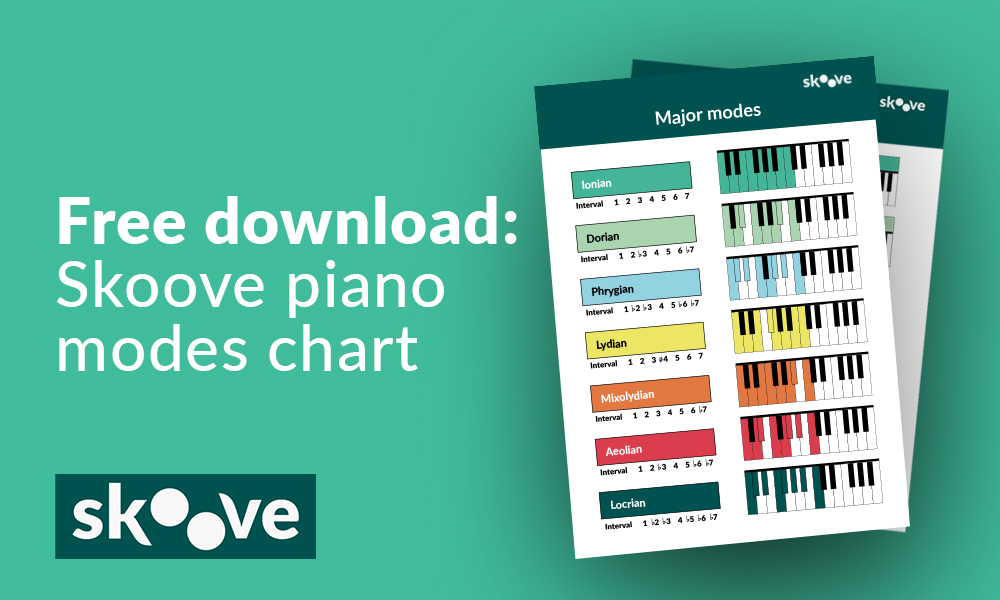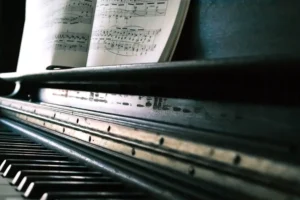What are musical modes?
Modes in music are scale patterns that are formed on notes within a scale. Each of the modes have their own unique sound, character and flavors, adding depth and color to musical compositions. Originating from some of the earliest forms of Western music, modes can be traced back to ancient Greece. As you progress in learning piano, modes will become increasingly essential and enrich your understanding, expanding your creative options. If you need the musical modes explained further you’re in the right place!
- Fall in love with the music - Learn your favorite songs, at a level suitable for you.
- Enjoy interactive piano lessons - Explore courses covering music theory, technique chords & more.
- Get real-time feedback - Skoove's feedback tells you what went well and what needs practice.

What are the differences between scales and modes?
A piano scale is a sequence of notes arranged in a specific order. Each scale has an interval pattern that defines its character. For instance, the interval pattern for a major scale is:
Tone, Tone, Semitone, Tone, Tone, Tone, Semitone.
Following this pattern from C gives us:
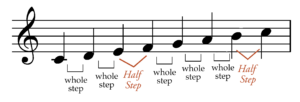
Notes: C D E F G A B
What are modes in music then? Modes in music theory are variations of a scale that start on different scale degrees. To understand this, take the C major scale (the ionian mode) and shift the starting note to the second degree, D.
Playing D to D with the same notes as C gives us the Dorian mode:

Notes: D E F G A B C D
By starting on different scale degrees modes create unique moods and character. We’ll explore different ways of understanding modes in music and apply them in this article.
Modes in the context of C major
A good rule to know is that each mode can be played with the white keys on a piano, using the notes of the C major scale. You can see that the modes are always named after their root note and are then labeled with a Greek name.
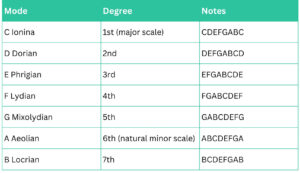
Check out Skoove’s handy downloadable list of musical modes to learn how to play modes on piano.
How to construct and play modes on piano
One way to work out a mode is to know how they relate to the major or minor scale. If you make alterations to a major or minor scale step pattern, you can convert them into different modes. First, let’s look at this list of modes linked to the major scale.
| Mode | Alterations to Scale | Notes |
|---|---|---|
| C Ionian | 1-2-3-4-5-6-7-1 No alterations. Same thing as the major scale. | C-D-E-F-G-A-B-C |
| C Dorian | 1-2-b3-4-5-6-b7-1 | C-D-Eb-F-G-A-Bb-C |
| C Phrygian | 1-b2-b3-4-5-b6-b7-1 | C-Db-Eb-F-G-Ab-Bb-C |
| C Lydian | 1-2-3-#4-5-6-7-1 | C-D-E-F#-G-A-B-C |
| C Mixolydian | 1-2-3-4-5-6-b7-1 | C-D-E-F-G-A-Bb-C |
| C Aeolian | 1-2-b3-4-5-b6-b7-1 Same thing as the natural minor scale. | C-D-Eb-F-G-Ab-Bb-C |
| C Locrian | 1-b2-b3-4-b5-b6-b7-1 | C-Db-Eb-F-Gb-Ab-Bb-C |
Constructing the 7 musical modes
As we have seen the seven musical modes relate to positions in a major scale. Modes of a full spectrum of tonal colour. However, due to their intervallic structure some are more suited to being categorized and understood as being either more major or minor. Let’s examine all seven modes starting with the more major examples ionian, lydian and mixolydian.
Ionian
The ionian mode is the same as the standard major scale and is not altered in any way.

Lydian
To create a lydian scale take any major scale and raise the fourth note a half step.
So, a C lydian scale would be:

C D E F♯ G A B C
This raised fourth degree gives a bright but interesting sound.
Mixolydian
To create a mixolydian scale take a major scale and lower the seventh note a half step.
The notes in C mixolydian are:

C D E F G A B♭ C
Mixolydian is a vibrant mode that brings a slightly bluesy, relaxed feel. The lowered seventh degree (B♭ instead of B) gives mixolydian its distinct sound, blending the brightness of the major scale with a hint of tension.
Next let’s dive into the four minor modes dorian, phrygian, aeolian and locrian and explore their unique characteristics, how to play them and where they’re used in music.
Dorian
To create a dorian scale take any major scale and lower the seventh and third notes a half step.
The notes in C dorian would be:

C D E♭ F G A B♭ C
The dorian mode is a minor scale with a brighter twist, thanks to its raised 6th (from the natural minor) note. This mode is perfect for creating a sound that feels minor but with a hopeful edge.
Aeolian mode
To create an aeolian scale take any major scale and lower the seventh, third and sixth notes a half step.
The notes in C Aeolian are:

C D E♭ F G A♭ B♭ C
The aeolian mode is the natural minor scale, the most familiar and widely used of all the minor modes. Its melancholic, expressive sound fits across genres.
Phrygian mode
To create a phrygian scale take any major scale and lower the seventh, third, sixth and second notes a half step.
The notes in C Phrygian mode are:

C D♭ E♭ F G A♭ B♭ C
The phrygian mode is a dramatic and exotic scale, characterized by its flattened 2nd note. It’s perfect for creating tension and drama, often evoking a Spanish or Middle Eastern feel.
Locrian mode
To create a locrian scale take any major scale and lower the seventh, third, sixth, second and fifth notes a half step.
The notes in C locrian are:

C D♭ E♭ F G♭ A♭ B♭ C
The locrian mode is the most unstable and rarely used mode. Its flattened 2nd and 5th notes create an unsettling and dissonant quality, making it ideal for dramatic or experimental music.
Parent scales
Knowing how modes relate to each scale is a great way of progressing your understanding of scales deepening your understanding of music theory as a whole. A useful way to work out a mode is to reference the order of modes in the table below. Once you know this, you can work backwards to find its parent scale.
| Key | Ionian | Dorian | Phrygian | Lydian | Mixolydian | Aeolian | Locrian |
|---|---|---|---|---|---|---|---|
| C Major | C | D | E | F | G | A | B |
| G Major | G | A | B | C | D | E | F# |
| D Major | D | E | F# | G | A | B | C# |
| A Major | A | B | C# | D | E | F# | G# |
| E Major | E | F# | G# | A | B | C# | D# |
| B Major | B | C# | D# | E | F# | G# | A# |
| F Major | F | G | A | Bb | C | D | E |
| Bb Major | Bb | C | D | Eb | F | G | A |
| Eb Major | Eb | F | G | Ab | Bb | C | D |
| Ab Major | Ab | Bb | C | Db | Eb | F | G |
| Db Major | Db | Eb | F | Gb | Ab | Bb | C |
| Gb Major | Gb | Ab | Bb | Cb | Db | Eb | F |
For example, using the table above, you can see that Lydian is the 4th note of the major scale. So, if you want to work out what the D lydian scale is, you need to think about which scale contains D as the 4th note.
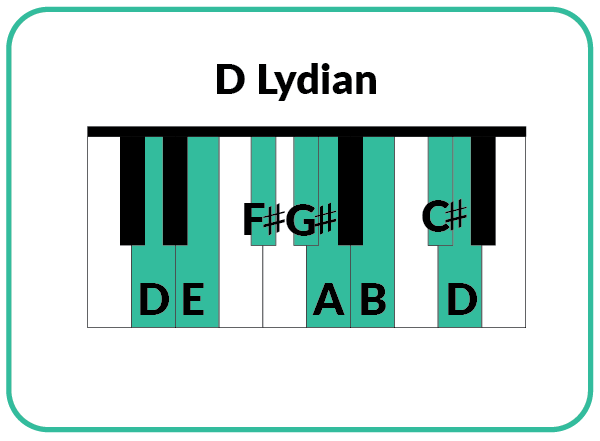
The answer is A Major which has three sharps C#, F# and G#. This means that D lydian also has these three sharps to create D major with a raised 4th degree.
Using the table above, you can see that mixolydian is the 5th note of the major scale. To figure out what the G mixolydian scale is, you need to identify the major scale in which G is the 5th note.
The answer is C major, which has no sharps or flats. This means that G mixolydian also has no sharps or flats, resulting in a G major scale with a lowered 7th degree.
Organizing modal sounds
Understanding these qualities will improve your perception of modes and how their distinct characteristics can alter a piece of music. Organizing modes from “brightest” to “darkest” shifts from the most open, uplifting sounds to those with a somber, tense quality. Here’s the list from bright to dark:
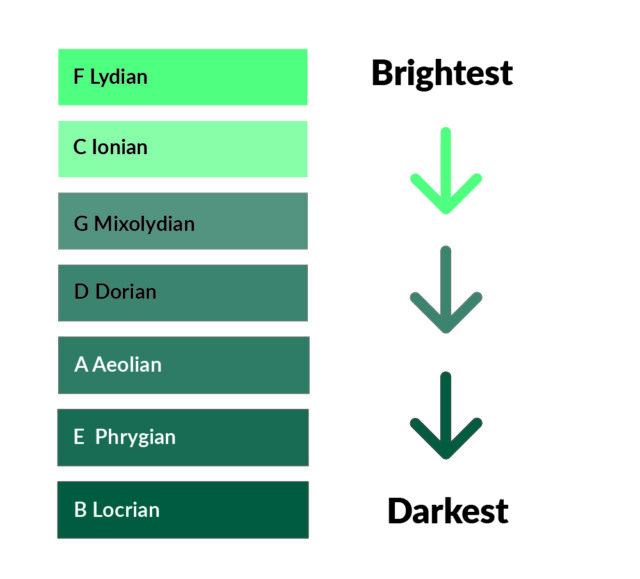
Try playing through the musical modes in order and notice what you hear; from lydian’s bright, uplifting qualities to locrian’s tense, dark dissonance, each mode offers unique atmospheres and emotional depth, showcasing the possibilities of modal interchange in music. The Skoove app can be of great help when learning modes. We have included a handpicked selection of classic tunes to familiarize you with each mode’s unique sound from brightest to darkest.
Ionian (Major) – No Woman No Cry – Bob Marley
The Ionian mode, identical to the major scale, is a bright, happy, and familiar sound. It’s the foundational scale in Western music that conveys joy and clarity. This reggae classic makes use of the ionian mode, pairing uplifting harmonies with heartfelt lyrics.
Lydian – Bye Bye Blackbird – Eddie Cantor
Lydian feels more uplifting than the major scale and often creates an airy, bright sound. This classic jazz standard and its rich chord progressions lend themselves well to an added lydian inflection adding a playful and airy quality to its vintage charm.
Mixolydian – Sweet Home Alabama – Lynyrd Skynyrd
Mixolydian is a major scale with a lowered seventh, this adds a subtle bluesy edge that tempers its brightness. This classic rock anthem embodies the mixolydian sound, a blend of bright, major tones with a soulful, bluesy edge.
Dorian – Scarborough Fair
Dorian is a minor mode with a natural sixth, making it feel brighter than Aeolian but still grounded in a minor tonality. This folk song makes great use of dorian’s major sixth for an interesting melancholic melody.
Aeolian (Natural Minor) – Moonlight Sonata – Beethoven
Aeolian, or the natural minor scale, is the classic minor scale with a melancholic, introspective sound. It is darker than dorian but still balanced, making it versatile for expressing sadness or emotional depth. A great example of this mode in action is Beethoven’s Moonlight Sonata.
Phrygian – Salt Peanuts – John “Dizzy” Gillespie
Phrygian has an exotic and mysterious quality due to its minor tonality and lowered second. This funky jazz tune is perfect for adding with phrygian infections through improvisation. It’s an excellent example of how the phrygian mode can be used in jazz improvisation.
Locrian (Darkest) – Cheek to Cheek – Irving Berlin
Locrian is the darkest mode, with a diminished fifth that gives it a highly crunchy, unstable sound.This beautiful tune can be given a unique twist with a locrian flavour, where its minor quality becomes more dissonant and edgy, adding a touch of tension and intrigue to the smooth melody and improvisations.
Now you’ve discovered all seven modes of the major scale and you have opened a door to a new world in music theory. For more helpful tips, lessons and a vast library of songs to explore be sure to check out the Skoove app to put your new modal knowledge to the test.
Author of this blog post
Vicki Young

Vicki Young is a pianist and singer with a degree in Music from the University of Sheffield. She lives in London, UK with her husband and son. Vicki is a communications and marketing freelancer who has worked with a range of organizations across the music and charity sectors.
Published by Lydia Ogn from the Skoove team








